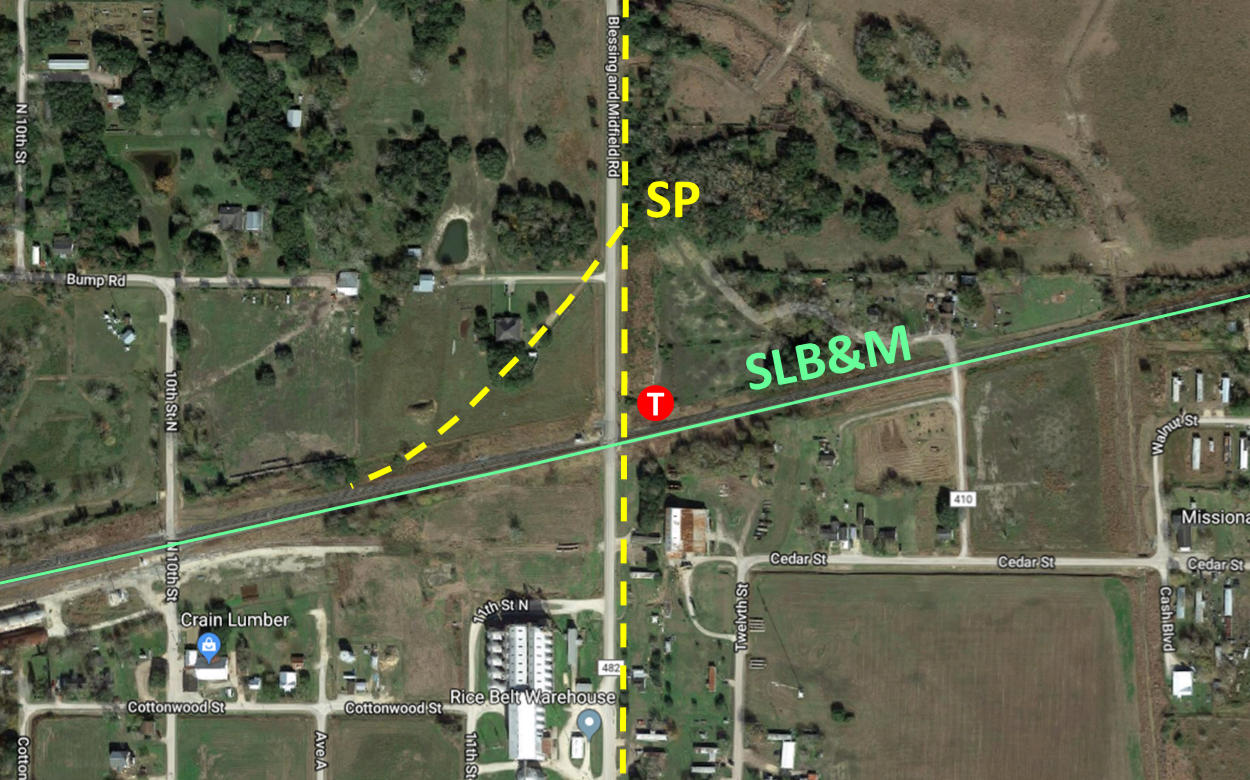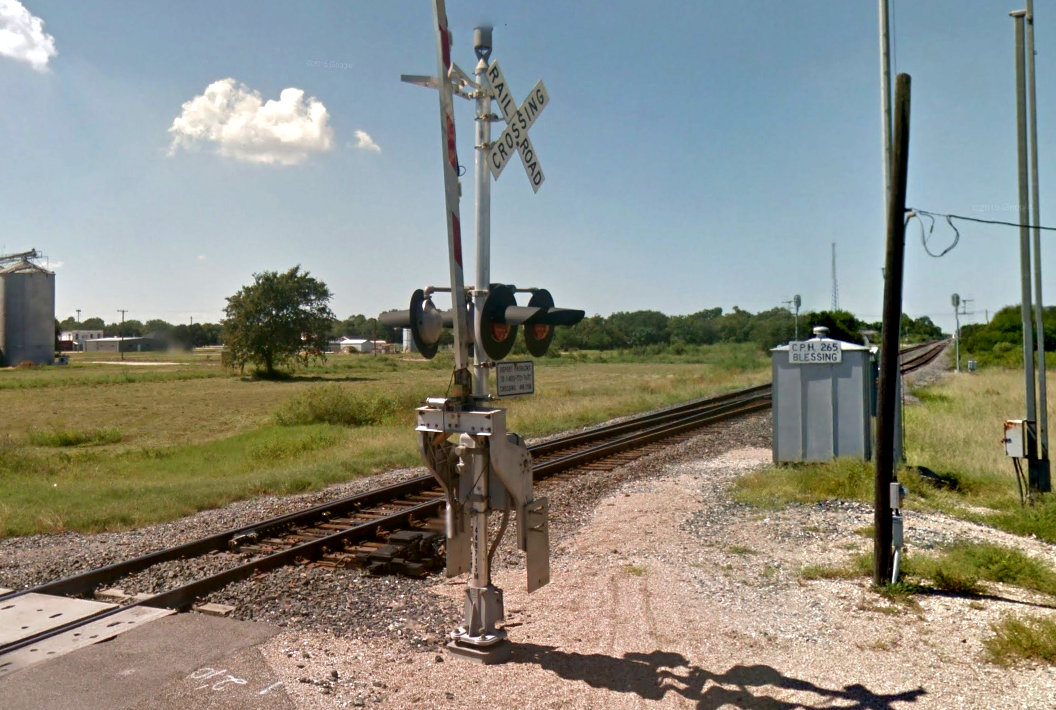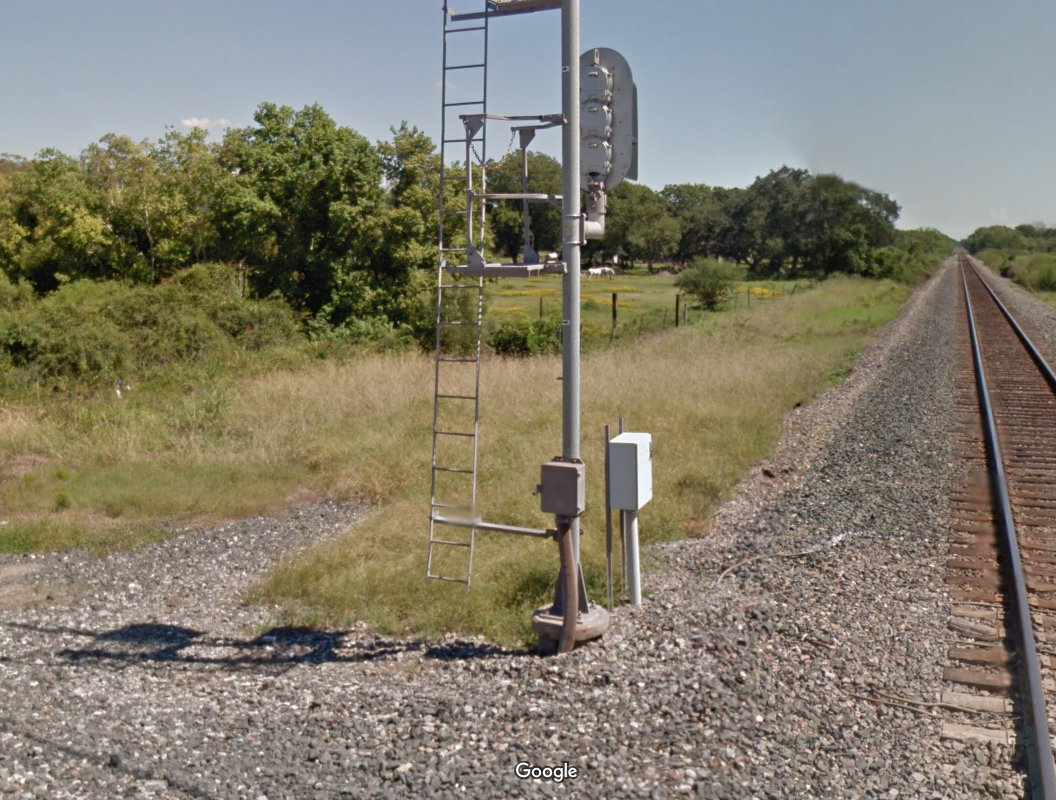Texas Railroad History - Tower 157 - Blessing
Crossing of the Galveston, Harrisburg & San Antonio, and the
St. Louis, Brownsville and Mexico railroads

Above: Looking out on
the St. Louis, Brownsville & Mexico (SLB&M) Railway tracks in the late 1930s or early
1940s, John W Barriger III snapped this photo from the rear of his business car
as he viewed the junction his train had just passed at Blessing.
Although Barriger was facing east-northeast at this point, his train was headed generally
south toward the Rio Grande Valley. The small white building with the window is
very likely the cabin where the Tower 157 interlocker controls were located. The
Southern Pacific (SP) tracks cross in front of the building with Palacios to the
right (south) and Bay City to the left (north.) In
the foreground, the only transfer track at Blessing ran diagonally between the
two railroads in the northwest quadrant of their crossing, confirmed by track
charts and historic USGS Topo maps. As the SLB&M carried substantially more
traffic than SP's line, the interlocker was most likely operated solely by SP
train crews when they needed to cross the SLB&M. The signals would otherwise be
lined to allow continuous movements on the SLB&M.
Grateful for the New York, Texas & Mexican Railway choosing to build through
his land in 1903, J. E. Pierce settled for "Blessing" as the name of the new
town he was promoting when the Post Office rejected his first choice of "Thank
God". The railroad, owned by Southern Pacific (SP) and merged into SP's
Galveston, Harrisburg & San Antonio (GH&SA) property in 1905, was building from
Bay City to Trespalacios (soon renamed Palacios), a town on Tres Palacios Bay
that had paid a bonus to SP to attract the railroad. In 1905, Blessing received
additional railroad service when the St. Louis, Brownsville & Mexico (SLB&M)
Railway crossed the GH&SA there when constructing a major rail line between Bay
City and Refugio. Despite service from two railroads, Blessing never grew much
beyond a few hundred residents.
According to Railroad Commission of
Texas (RCT) documentation, they commissioned Tower 157 for operation on August
27, 1929. SP documentation states that the cabin went in service a few months
earlier on May 1. It was a mechanical cabin interlocker with power-operated
distant signals located in the northwest corner of the crossing diamond. The
interlocking plant had a 12-lever control frame, with four levers
controlling signals, four controlling derails, and two controlling facing point
locks. From the photo above, it appears that the original cabin was replaced
with a larger structure on the northeast corner of the diamond, which might have
served as a depot. Modifications to the interlocker were authorized by RCT on July 18, 1941
and August 10, 1948, but the details are unknown. SP's branch line to Palacios was abandoned in 1985,
eliminating the need for the interlocker. The ex-SLB&M line continues to
function as a major rail artery between Houston and the lower Rio Grande Valley,
currently owned by Union Pacific.
Site Photos, Blessing, Texas
(Jim King, December 2006)

Above: This photo from
December, 2006, shows a small metal pole on the north side of the ex-SLB&M
tracks immediately east of the County Road 482 grade crossing. The SP tracks
crossed just beyond the pole, and the cabin visible in Barriger's photo
would have been located near the pole. The pole is the remnant of the type of
control box often
associated with a simple interlocker that is used for lining the distant signals
for the crossing. The pole was most likely installed when the cabin was
dismantled.
Satellite Map, Blessing

Google Street Views, Blessing

Above: Looking southwest at
the Farm Road 482 grade crossing, the headlight of an approaching train is
barely visible in the distance. The interlocker cabin was on the opposite side
of the road. Below: The
opposite side of the road. This 2013 view shows that the control box pole
visible in the 2006 photo is gone.





